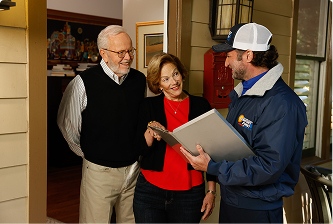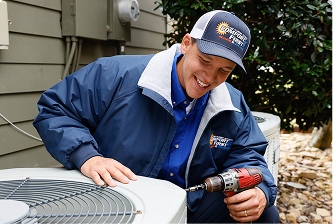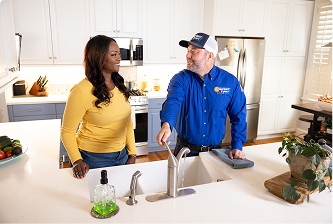Summary
- Turn off power and gas to prevent hazards after HVAC flooding.
- Inspect outdoor units and crawlspace components for damage.
- Call certified HVAC technicians for safe system restoration.
What Should You Do If Your HVAC System Or Crawlspace Floods During The Hurricane?
One of the worst feelings as a homeowner is waiting out a storm, wondering what kind of damage awaits you on the other side. And a flooded HVAC system is almost just about as bad as it can get.
That is why Comfort First has put together this guide to help you troubleshoot your flooded or storm damaged system. Read our 6 Steps to Safely Address a Flooded System, and give us a call if you determine your system may be in need or repair or replacement. We’ll even help you work out the details with your insurance company!
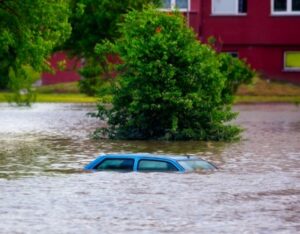
Follow our 6 Steps To Safely Address a Flooded HVAC System, below:
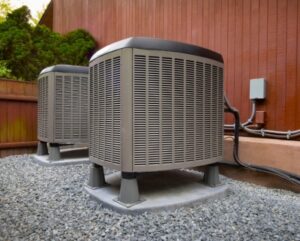
1. Turn off the electrical breaker feeding all pieces of HVAC equipment in your home. Typically there will be one indoor piece for every outdoor unit that you have. The breaker should be labeled in the panel as A/C or HP or Air handler or Gas Furnace, etc.
2. Shut off the gas supply to gas furnaces or gas package units. Normally there will be a gas shut off near the piece of equipment.
3. Check your outdoor HVAC equipment. HVAC equipment outside of you home also has electrical and gas connections that will be harmed if submerged in water. In a split system application there are both high and low voltage circuits and refrigerant piping feeding these outdoor units. If the units are shifted or moved by flood waters, these circuits could pull loose from their connections or the refrigeration piping could break causing the refrigerant to leak out.
4. Check electrical HVAC system components in your crawlspace. HVAC equipment that is under your home, has quite a few electrical and gas components that don’t perform very well when wet. The electrical components can short out and fail and gas systems have valves and control that may fail if flooded. If your equipment or crawlspace is under water at any time during the storm “DO NOT” attempt to turn it back on. This could cause more damage and could cause you electrical injury or death. You system should be checked by one of our certified HVAC service technicians before attempting to return it to operation.
5. Inspect your crawl space ductwork. Duct work under homes that becomes flooded can become a breeding ground for mold, mildew, and bacteria, when it becomes wet. Once the insulation within the duct work becomes wet it is impossible to decontaminate.

For this reason, if any part of your duct system becomes flooded or water damaged, it “MUST BE” replaced to prevent the bacteria rich air from entering your home. Call an Comfort First Heating & Cooling! We will assist you in determining what steps to take next, if this happens to your home.
6. Call a trusted HVAC provider to help you wade through the insurance claim process. Many of the HVAC issues related to flooding will be covered by your home insurance policy. Know what your plan covers and doesn’t cover. You don’t have to do this on your own. Comfort First is here to help. Most insurance companies require a proposal of the work that needs to be performed prior to approving your insurance claim.
By calling us first, one of our project managers will come out, assess the damage, and provide a professional proposal that you can easily submit to your insurance company as quickly as necessary. This assessment will take about 60 to 90 minutes and you’ll have a proposal to submit to your insurance company that will allow you to get you air conditioning and heating system back up and going as quickly as possible.
Flooded HVAC FAQ
What should I do if my HVAC system gets flooded?
Immediately turn off the power and gas supply to your HVAC system to prevent electrical hazards and gas leaks. Then, contact a certified HVAC technician to assess and repair any damage.
Can I use my HVAC system after a flood?
No. Using your HVAC system after it has been flooded can cause further damage and pose safety risks. Have it inspected by a professional before turning it back on.
How do I know if my HVAC ductwork is damaged by flooding?
Signs include musty odors, visible mold, or reduced airflow. A professional inspection can determine the extent of the damage and whether cleaning or replacement is necessary.
Will my insurance cover HVAC flood damage?
Coverage varies by policy. Contact your insurance provider to understand your coverage and file a claim if applicable.
If you believe your HVAC system and/or crawlspace was flooded and is in need of an inspection or repair after this season’s latest storm, contact the trusted team at Comfort First, today at (833) 861-4635!



